When Jessica Beltran’s mom noticed her infant daughter wasn’t growing eyebrows and eyelashes, she brought her to see a doctor.
At just six months old, Jessica was diagnosed with alopecia. In the early years of her life, she had alopecia areata, a form of the condition where hair falls out in small round patches. At this point, the doctors thought there was a chance of doing a hair transplant using graft but now we’re just not sure if it will be possible. While she had bald patches, she also had “big, thick, black Mexican hair” to cover them, and normal eyebrows and body hair.
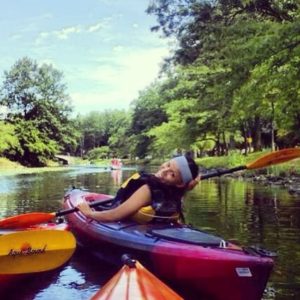


“I eventually stopped because I was like ‘there’s no point, I’m not going to go into universalis,” Jessica explains.
Universalis is the most advanced form of alopecia, involving rapid loss of all hair, including eyebrows and eyelashes. Despite her earlier doubts, Jessica soon found herself drifting further in that direction.
She remembers the exact day it started, her 12th birthday. Jessica’s head was itchy when she went to bed and she just kept scratching it, thinking excitement from her birthday was the cause. When she woke the next morning, her pillow was covered with hair; just two weeks later, her hair was basically all gone.
“I held onto two strands of hair and put that in the ponytail because I refused to let it go, until finally those just fell out too and I was bald at 12,” she recalls.
At that time, Jessica went to great lengths to hide the changes she was going through from everyone but her family.
She wore a hairpiece every day, even when playing sports. As a softball catcher, she had to be careful to avoid ripping off her hairpiece when she removed her helmet. As a defensive specialist in volleyball, she was hesitant to dive for fear that her hairpiece would fall off.
The time spent trying to make herself look like everyone else added up. Between putting on her hairpiece, putting on false eyebrows, and applying eyeliner, it took an extra 45 minutes each day for Jessica to get ready.



In middle and high school, she was given some nicknames she disliked; peers called her “the bald eagle” or “the girl with the hairpiece.” Jessica was aware that people, boys especially, looked at her differently, and that caused a lot of pain during her teenage years.
Only her closest friends and her family could see her without her hairpiece. If her brother invited friends over and gave her less than an hour’s notice, she would scream and stay in her room. When she heard the doorbell ring, she would run upstairs to prevent anyone from seeing her “like that.”
By her junior year of high school, she had quit softball and volleyball. This was in part because the competitiveness had made it less fun for her, and in part because it had gotten harder and harder to play in a hairpiece.
“I decided to quit sports instead of quitting the hairpiece,” she says. “It was a bad decision, because here I am, still active as ever.”
It was during 2001 that Jessica attended her first alopecia conference, in Oakland, Calif.
At that point she was still wearing a wig every day, but felt a strong connection to others at the conference who also had alopecia and could identify with her struggles. Through the years, she has attended many similar conferences and met many of her best friends at them. She is even an “Auntie” for two children of one of these friends.
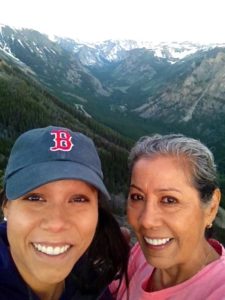


At that point, Jessica had retreated into an areata stage of alopecia, and the hair that had returned grew to chin-length. She had also grown more comfortable with herself and her condition. She had friends-both from the conferences and from school-who understood her situation and were there to support her.
Jessica was an undergraduate student at Northwestern University in Evanston, Ill., where she earned a bachelor’s degree in Biology and Psychology. While studying abroad in Sydney, Australia as a college junior in 2008, one of Jessica’s friends recommended she try extensions. She loved them and had long hair until summer, 2014.
She then spent three years as a Senior Research assistant and Rheumatology Lab Manager in Boston before returning to school. She received a Master of Science in Conservation Medicine from the Cummings School of Veterinary Medicine at Tufts University in North Grafton, Mass.
Amid the stress of finishing her thesis and moving from Boston to Seattle, where she knew hardly anyone, her hair began falling out again last year. When she was 12, her hair had taken just two weeks to completely disappear; this time the process took nearly seven months. However, this time she was better equipped to accept the change, choosing to shave her head on Aug. 8, 2014.
“I took the plunge, and this time around I was ready to deal with it,” Jessica says.
Though she embraced the transition to a bald head better at 26 than she did at 12, she still wanted to have a hairpiece, especially while navigating the rituals of making friends, meeting people, and interviewing in a new city.
“I was a working professional, I had a graduate degree, I’d gone through college, I knew who I was,” Jessica said. “I got the hairpiece kind of as a security ‘in case.'”
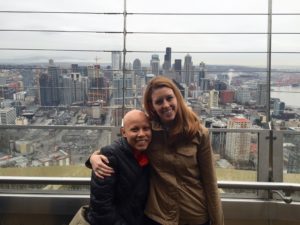


“I didn’t want to go inauthentic, because I came out here to be who I was always, just in a new environment,” Jessica explains. “And it just ended up coinciding that when I moved out here I would have to reinvent my look.”
The responses she got about her condition during interviews were a mixed bag. At one interview, she told interviewers in advance she had alopecia universalis, but that she was totally healthy. That interview went off without a hitch.
During another interview, she forgot to mention it beforehand, and a question was clearly on the interviewer’s mind throughout their conversation.
“She kind of leaned forward and was trying to say, ‘this is a long-term position. You’re very qualified for this, but health-wise,'” Jessica recalls. “She was looking at my head too, and I can tell when people don’t want to say ‘cancer.’ It’s a touchy subject for anybody.”
[tweet_box design=”default”]”Everybody has their own little vulnerabilities. Mine’s just a little more obvious. But I use it as a strength.” – Jessica, #alopecia[/tweet_box]
At that point, Jessica stopped her interviewer and explained her situation, and the interview proceeded without further incident.
She’s grown to hardly notice the reactions of others; it’s often her friends who take offense to the stares or remarks of others that she hadn’t even noticed. Once in a while, strangers think they can touch her head, like a pregnant woman’s belly, and that’s where she draws the line; but she loves when her friends do it.
“It’s a sign of tenderness and protectiveness of my vulnerability,” Jessica says. “I really appreciate that love.”
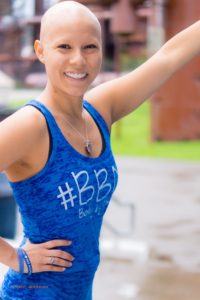


She says a big part of life for those with alopecia is coming to terms with things in whatever way works best for each person.
“Honestly, it’s just hair,” Jessica says. “Some wear hairpieces, some don’t. Some are in between like I was. Do whatever you want, just make sure you own it.”
Jessica is a self-proclaimed “endorphin junkie” and has begun to embrace her new Seattle home, spending as much time in the mountains, on the water, hiking, and biking as she can. A far cry from the anxiety she felt during her teenage years, and to some extent during her big move, she has been able to put her alopecia in perspective.
“Everybody has their own little vulnerabilities.” Jessica explains. “Mine’s just a little more obvious. But I use it as a strength.”

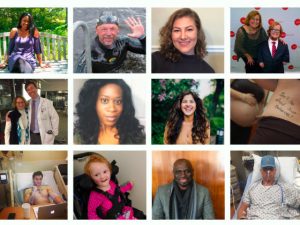
Wow! Beautifully put, thanks for sharing your transformational and inspiring testimony!! So much power and miracles found within!!